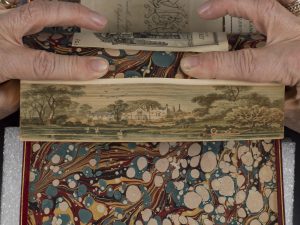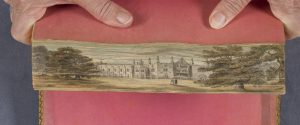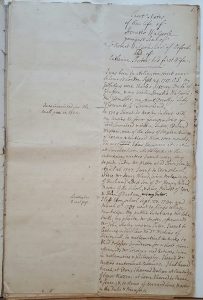J.H. Müntz’s designs for Dickie Bateman’s Grove House, Old Windsor


by Matthew Reeve, Associate Professor and Queen’s National Scholar, Department of Art History & Art Conservation, Queen’s University
In one of Horace Walpole’s clever commentaries on the new Gothic style, he described the transformation of Dickie Bateman’s villa at Old Windsor in two characteristically witty turns of phrase: “[I] converted Dicky Bateman from a Chinese to a Goth…I preached so effectively that every pagoda took the veil”; and that Bateman’s house had “changed its religion […] I converted it from Chinese to Gothic”. Walpole positions himself as a teacher and Bateman as a disciple whom he convinced to change his tastes from Chinoiserie (“the fashion of the instant”) to the Gothic, the style “of the elect”.[1]
“The elect” was not a socio-economic category, but a tongue-in-cheek reference to Walpole’s own circle of friends and associates and their shared Gothic idiom. Walpole’s allegory of stylistic change as national and religious conversion was based in part on the fact that he provided the conduit for two of his closest designers in the Strawberry Committee—Richard Bentley (1708-82) and Johann Heinrich Müntz (1727-98)—to design Gothic additions to the Priory. Rebuilt and expanded in the fashionable mode of Strawberry Hill and by its designers, from Walpole’s perspective at least, Bateman’s works at Old Windsor served to reinforce his role as arbiter of the Gothic taste and Strawberry Hill as its paradigm. Plans to renovate the house began in 1758, coinciding with Walpole’s visit in that year.[2]
The three drawings at the Lewis Walpole Library are for Bateman’s new dining room and are dated to 1761. They are now part of LWL Folio 75 M92 761, the Library’s stunning oversized portfolio of Müntz’s works. They are important testaments to Bateman’s architectural patronage and they provide vital visual testimony of the eighteenth-century history of the house of which precious little now survives.[3] Another part of the house is probably also preserved at the Lewis Walpole Library—Richard Bentley’s drawing of a cloister very likely relates to the original cloister at Old Windsor that connected the house to Müntz’s dining room (49 3585c). Although aspects of the ornament of the dining room is common to Müntz’s other drawings—particularly the screen of St Alban’s Abbey that he favoured—the octagonal form is unprecedented in Walpole’s oeuvre.
Walpole’s account of Bateman’s Old Windsor demands nuancing. Framing himself as the reigning doyen of the Gothic taste, he carefully sidelines Dicky Bateman, a senior man of taste, who in fact built some of the most significant statements of the Gothic and Chinese taste in the 1730s through 1750s at Shobdon Church and Court in Herefordshire, the early building works at Old Windsor, and in a series of garden and “interior design” commissions for aristocratic patrons. His role as an arbiter of the modern styles and of Chinoiserie in particular was celebrated in Robert Levrac-Tournières’s 1741 portrait (now Birmingham Art Gallery) and Walpole’s description of him as “the founder of the Sharadwagi [Chinese] style”.[4] A member of the homoerotic circle around Lord Hervey, Stephen Fox, and others, Bateman was a leading man of taste in London when Walpole returned from the Grand Tour and one of the models Walpole emulated in the early 1740s and 1750s. Emulation of Bateman undoubtedly informed Walpole’s thwarted attempt to acquire the White House at Old Windsor directly beside Bateman in 1746 (then owned by their mutual friend Sir Charles Hanbury Williams), prior to purchasing Strawberry Hill.[5] Old Windsor was, as Walpole hoped Strawberry Hill would be, a cause célèbre of London society from the 1730s through 1760s. But it was also a building that visitors understood to elide Bateman’s queer persona with the its fussy, hybrid style. Described as “fribble” or “fribblish”, the house was considered an architectural projection of the outrageously effeminate character Mr Fribble from David Garrick’s 1747 Miss in Her Teens, who was, in turn, apparently based on Bateman himself or on Walpole.[6]
[1] Yale Correspondence vol. 37, 359; Yale Correspondence vol. 10, 43.
[2] Yale Correspondence vol. 14, 102.
[3] The fullest account of the house is now Matthew M. Reeve, “Dickie Bateman and the Gothicization of Old Windsor: Architecture and Sexuality in the Circle of Horace Walpole”, Architectural History 56 (2013), 99-133.
[4] Yale Correspondence vol. 35, 359.
[5] Yale Correspondence vol. 9, 39 to Montagu 2 Aug 1746; T. Eustace Harwood, Windsor Old and New, 319–20.
[6] On the reception of Old Windsor, see Reeve, “Dickie Bateman”, 118-24.
Bibliography
Harwood, T. Eustace. Windsor Old and New, (London: 1929).
Lewis, W. S. (ed.). The Yale Edition of Horace Walpole’s Correspondence, 48 vols
(New Haven: Yale University Press, 1937–83).
Reeve, Matthew. “Dickie Bateman and the Gothicization of Old Windsor: Architecture and Sexuality in the Circle of Horace Walpole”, Architectural History 56 (2013), 99-133.

![[Lady Elizabeth Laura, Lady Charlotte Maria & Lady Anne Horatia, daughters to James late Earl of Waldegrave Knight of the Garter]](https://campuspress.yale.edu/walpole300/files/2017/08/lwlpr16495-q7mgs9-300x262.jpg)










